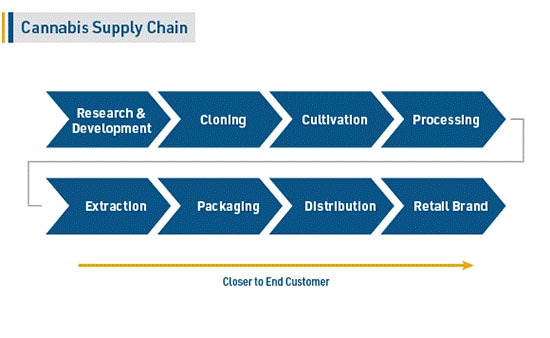There are two ways businesses make money in the cannabis industry: Get as close to the customer as you can with a brand - or innovate.
Innovation is not just about invention. There are many ways to go about it. And any company can do it, provided the art of discovery resides deep within its DNA.
Some companies focus exclusively on creating new technologies and processes.
Place them on a map of the cannabis supply chain, and you'll see pure innovators work about as far away from the customer as one can get:

But some sectors of the cannabis industry are more prone to adding value through innovation than others.
These are the "sweet spots" - the spots where the profits are. And they're easy to find with a quick walk through the cannabis industry...
Cannabis Supply Chain 101: Finding the Profits
Let's start with an area that does not lend itself to earning excess returns for investors: cultivating cannabis.
Farmers tend to be so efficient that any edge developed through innovation is quickly adapted by other growers. Either that happens, or other growers scramble just as hard to gain that same efficiency by other means.
In either case, this constant pressure quickly erodes the pricing power any single grower may have achieved.
Gains are temporary, and so is the value add. Moreover, the skillsets farmers rely upon to make them so efficient do not lend themselves to groundbreaking innovation.
The same goes for processing and extraction.
Sure, companies in these sectors claim they have a breakthrough process. But any cost advantage they gain over the competition burns away quickly for the same reasons as it does for the farmer.
Again, it's all about efficiency and the constant grind to eke out every ounce of performance from the equipment they maintain.
Now, that doesn't mean these companies can't find some other edge.
They can build brands around the consistency of their flower or extract.
What I mean by that is companies operating in this sector build relationships directly with the end consumer. They build a brand or reputation that customers come back to time and again. They create an experience that cannabis consumers pay a premium to enjoy.
A brand can be two things. First, it could be a product or suite of products: a line of premium, pre-rolled joints, a high-quality vape, or infused edible that consistently delivers on quality, taste, and effect. These products will be the Coca-Cola or Smart Water of cannabis.
A brand can also be a retailer. Operating stores where customers feel welcome and know that they can trust the products sold provides a lot of value. The retailers exercise pricing power over the companies attempting to get products on their shelves.
CVS and Walgreens are examples of retailers as brands that consumers trust. So is Walmart, and it wields enormous power over product manufacturers.
And when looking at a multi-state operator (MSO), you want to see how effective its retail store brand is at building customer trust.
But companies that are the best at developing strains don't tie up precious capital in farming. They innovate strains and contract with growers to produce them. Only very few growers or extractors can manage to do both.
And when you add a second dimension to the Cannabis Supply Chain graph above - one that captures how much money is left for investors at each stop along the cannabis supply chain - you'll see an interesting pattern emerge.
This Is What to Look for in the Cannabis Supply Chain
It’s called the value chain smile curve.
The higher a sector plots on the graph, the more value that sector tends to capture for shareholders.
Here’s how it works...
The dotted plots on the graph directly correspond to the cannabis supply chain I mentioned above.
At the very far top left is the research and development. At that stage, the product is about as far away as it gets from the consumer since it isn't ready yet.
And all the way at the far top right is the retail brand that can charge triple or double what it costs to make the product – that’s where the value increases.
The “dead zones,” so to speak, which are in the middle of the smile curve, are the cultivation and processing – or the farmers – because those margins are razor thin.
And packing and distribution companies operate on thin margins, as well.
Take a look…

As industries mature, the producers and processors in the middle lose all pricing power.
Meanwhile, companies focusing on research or building brands capture most of the value the industry has to offer.
This pattern is not unique to cannabis. It's typical of almost any industry.
Focusing on these sweet spots is exactly how I approach picking cannabis stock recommendations for our NICI Membership subscribers.
I want to recommend those names we believe are best positioned to capture the lion's share of the profits from the cannabis boom - and many of these are trading at a massive discount right now.
You can learn more about the NICI Membership and find out how to access these premium cannabis plays right here.
Follow Money Morning on Facebook and Twitter.
About the Author
Don Yocham is Executive Director for the National Institute of Cannabis Investors (The Institute) and Director of Cannabis Investing Research for Money Map Press. Before starting his role with the Institute, he was the Head of Private Deals for the publication Cannabis Venture Syndicate. From his first foray into the trading pits of Chicago to introducing institutional investors to entirely new markets in the early 2000s, Don has pretty much covered the entire field of investing in his 25-year career. In the depths of the financial crisis, when the typical investor had lost more than half of their money, his portfolios were up.



